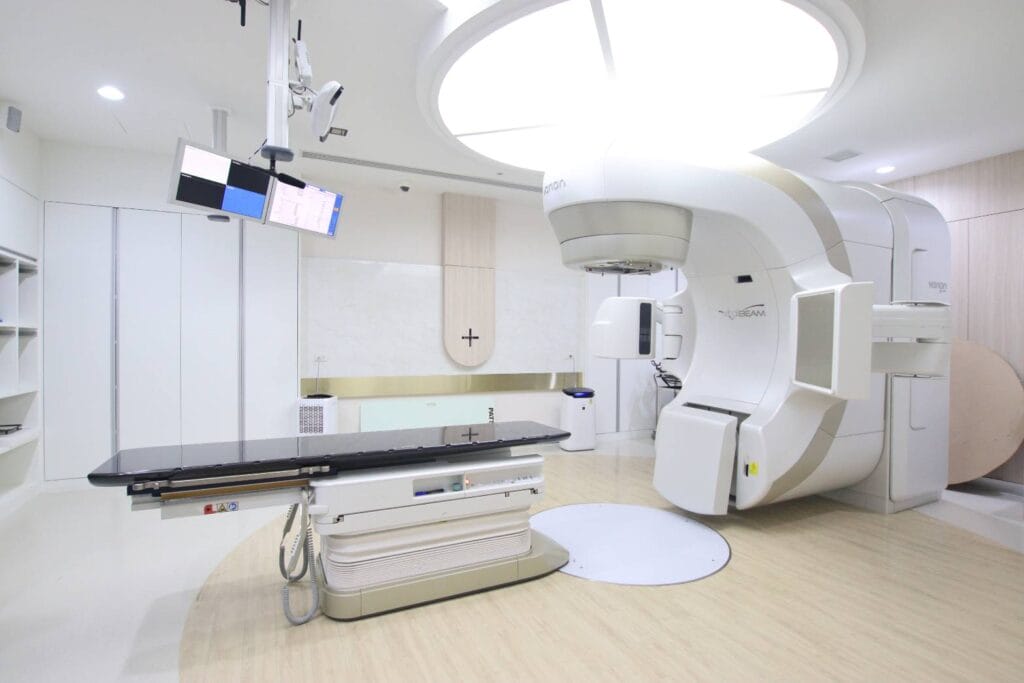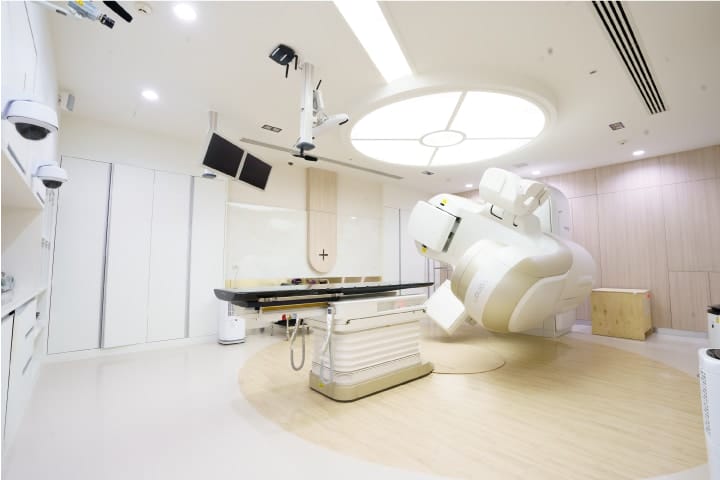โรคมะเร็ง และรังสีรักษา
Thainakarin Cancer Center
บริการรักษาผู้ป่วยโรคมะเร็งด้วยเครื่องมือทางรังสีรักษาที่มีเทคโนโลยีขั้นสูงและทันสมัย
โดยมีทีมแพทย์เฉพาะทาง ร่วมกับสหสาขาวิชาชีพที่หลากหลาย
Currently, cancer is considered a personalized disease because of abnormalities at the genetic or DNA level, which vary from person to person. The most effective cancer treatment involves a combination of various methods, including surgery, chemotherapy, and radiation therapy. Thainakarin Hospital has treatment processes and modern medical technology tools that lead to diagnosis, treatment, and post-treatment rehabilitation for effective results and minimizing effects or side effects and adverse reaction.

LINAC CENTER
Linac Center at Thainakarin Hospital is ready to provide cancer care services to patients with advanced and modern radiotherapy equipment. With a specialized team of medical professionals, they offer consultation and treatment in collaboration with various interdisciplinary fields. Thainakarin Hospital aims to deliver effective Personalized Cancer Care. The radiation therapy services are available at Linac Center, located at the back of the hospital,
from Monday to Friday, 08:00 to 16:30.
For inquiries, call (+66) 62-590-1919.
Cancer and Radiation Therapy
Radiation therapy is a component of cancer treatment. In most cases, cancer treatment involves a combination of surgery, chemotherapy, and radiation therapy. Approximately 50% of cancer cases use radiation therapy. Examples of cancers treated with radiation therapy include breast cancer, lung cancer, and cervical cancer.
𝙑𝙞𝙩𝙖𝙡 𝘽𝙚𝙖𝙢
is a radiation machine that uses high-energy X-rays to destroy the DNA within cancer cells to inhibit their growth and eventually cause the cancer cells to die. It can adjust the radiation beam pattern to suit the size and shape of the cancerous tumor. The radiation treatment typically takes 10-15 minutes per session, and the intensity of the radiation can be adjusted. The machine rotates around the patient, targeting and destroying cancer cells while minimizing the impact on adjacent normal organs. Importantly, this treatment allows the patient does not need to stay in the hospital.


The Cancer and Radiation Therapy Center at Thainakarin Hospital is now ready to provide services. All cancer patients on medical welfare have access to effective cancer treatment through the Eastern Cancer Network, which includes Thainakarin Hospital, Samrong General Hospital, Cancer Alliance Sriracha Hospital (CAH), and Saha Clinic Chachoengsao (SCC).
Currently, radiation therapy technology has advanced significantly, enabling precise treatment, better disease control, and reduced side effects on surrounding normal tissues.
- Breast cancer
- Colorectal cancer
- Prostate cancer
- Head and neck cancer
- Lung cancer
- Esophageal cancer
- Cervical cancer
- Brain cancer
Radiation Therapy
External Beam Radiation Therapy
It is a treatment using radiation that comes from a radiation generator located away from the patient's body. It starts with using a CT simulator to determine the position, boundaries, and size of the lesion, and adjacent organs. Physicians and medical physicists use the obtained images to simulate the treatment plan. The next step involves delivering the planned treatment using a linear accelerator using radiation techniques such as Three-Dimensional Conformal Radiation Therapy (3DCRT), Volumetric Modulated Arc Therapy (VMAT), and Stereotactic Body Radiation Therapy (SBRT). where the doctor selects a technique that is appropriate for the disease and the patient, making the radiation treatment more accurate, and effective, and minimizing the duration of exposure.
Brachytherapy
...
Radiation procedure
- The doctor assesses the patient's physical health before starting treatment and discusses the treatment approach.
- Then make an appointment for the patient to simulate radiation using a computerized tomography machine to generate images for treatment planning through computer systems.
- During radiation therapy, the patient is held in a stationary position with a fixation device. The radiation therapist verifies the positioning before every session.
- Radiation treatment takes approximately 15-20 minutes per day, five days a week, and takes approximately 4-8 weeks, according to the type of disease and the doctor's treatment plan.
Medical Technology
Treatment simulator (Philips : Big bore radiation therapy)
A computed Tomography scanner and simulator are used to simulate 3D images to determine the position, shape, and size of the cancerous tumor and nearby organs. It is connected to a computer system for treatment planning. It enables physicians and medical physicists to precisely plan the size and direction of the radiation beams.
Linear Accelerator (Varian; Vital Beam)
A radiation machine that uses high-energy X-ray radiation can adjust the radiation beam pattern to suit the size and shape of the cancerous tumor. It destroys cancer cells while minimizing the impact on surrounding normal organs. The duration of irradiation is 10-15 minutes per session, and the patient does not need to stay in the hospital.

Vital Beam
Radiography Techniques
Three Dimensional Conformal Radiotherapy (3D-CRT)
is a treatment that uses computerized tomography images to visualize tumor masses and normal organs in three dimensions to define the treatment boundaries based on CT images. Through the CT simulation method, the radiation dose distribution becomes more uniform and accurate, allowing higher radiation doses to be delivered specifically to cancerous cells and reducing the amount of radiation that hits normal tissue around cancer cells.
Intensity Modulated Radiation Therapy (IMRT)
is an advanced development of Three-Dimensional Conformal Radiotherapy (3D-CRT). It allows for the customization of radiation doses to suit the thickness or thinness of a cancerous tumor. It is a method that utilizes varying intensities of radiation and includes a diverse set of radiation sizes., resulting in optimal coverage of the affected area. As a consequence, the surrounding organs of the tumor receive lower radiation doses compared to traditional radiotherapy techniques.
Volumetric Modulated Arc Therapy (VMAT)
is the latest radiation therapy technique developed from Intensity-Modulated Radiation Therapy (IMRT). It involves adjusting the intensity of the radiation, controlling the rotational speed, the amount of radiation, and the movement of the Multileaf Collimator (MLC). Therefore, it helps reduce the duration of radiation treatment and minimize errors resulting from patient movement as well. Additionally, VMAT allows for more precise and efficient radiation delivery by customizing the radiation dose to match the thickness and density of the tumor. Make it cover as much of the lesion area as possible. As a result, the surrounding organs of the cancer tumor Receive less radiation than traditional radiation techniques.
Radiosurgery
Radiosurgery is a treatment method that delivers a high dose of X-ray radiation precisely to the target with accuracy. The purpose is to destroy the tumor or cancer. It is employed as a primary treatment when surgery is not feasible or as an adjuvant treatment following surgery. This approach can be utilized for the brain, spinal cord (SRS/SRT), and body areas (SBRT) such as the lungs and liver. Radiosurgery differs from general radiation therapy in that it involves delivering a higher dose of radiation per session, but the total number of radiation sessions is typically fewer. Furthermore, radiosurgery can limit the high dose of radiation to the specific area of the tumor or cancer, better than general radiation therapy.
Stereotactic Radiotherapy (SRT)
is a high-dose radiation therapy delivered in 3-7 sessions for tumors located in the head or spine. This approach aims to reduce side effects from single-session radiation therapy. However, it has limitations in requiring specialized equipment. It allows for precise positioning.
Stereotactic Body Radiation Therapy (SBRT)
Stereotactic Body Radiation Therapy (SBRT) is a high-dose radiation treatment for tumors located in the body, such as the lungs, liver, or lymph nodes. This approach involves delivering radiation in 3-7 sessions.







